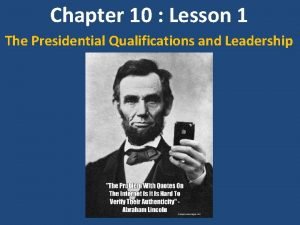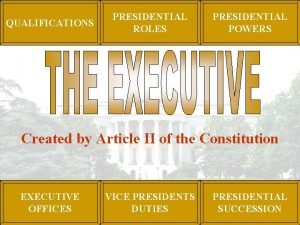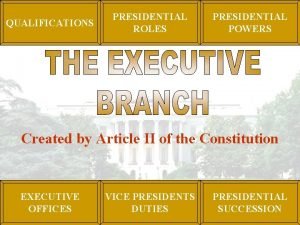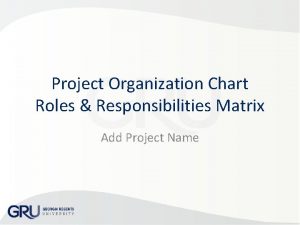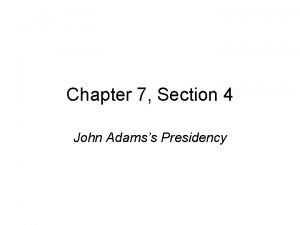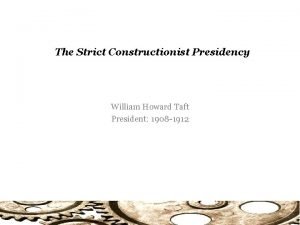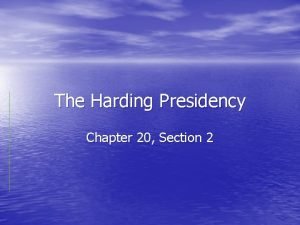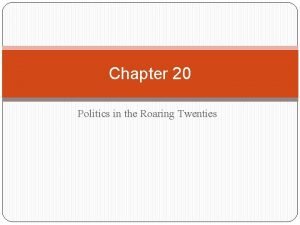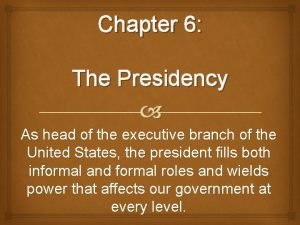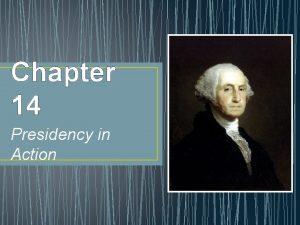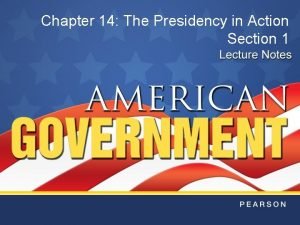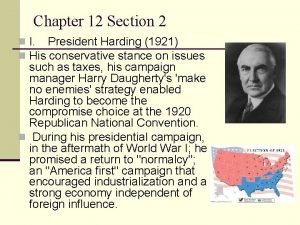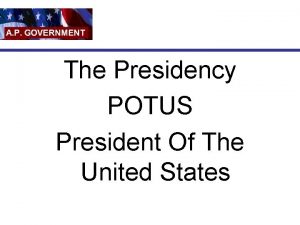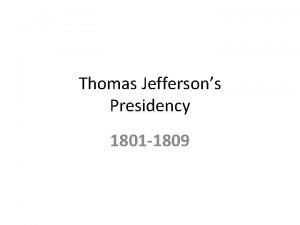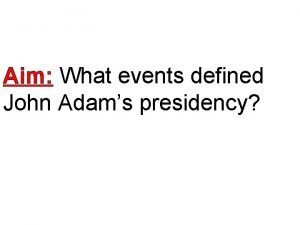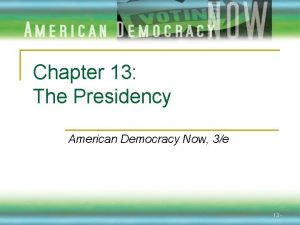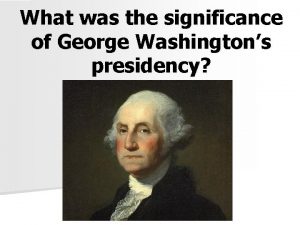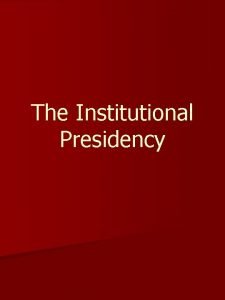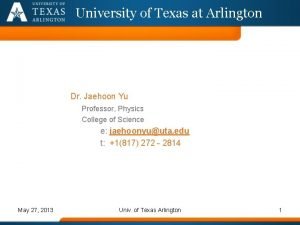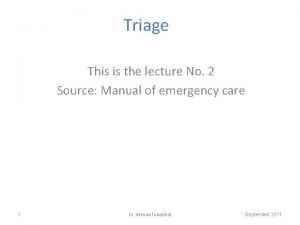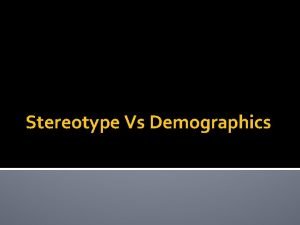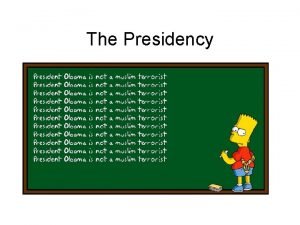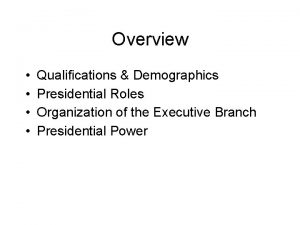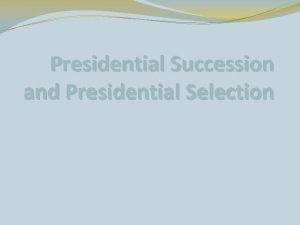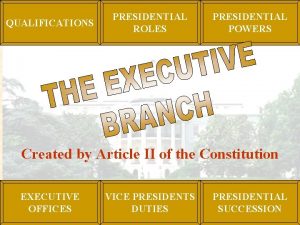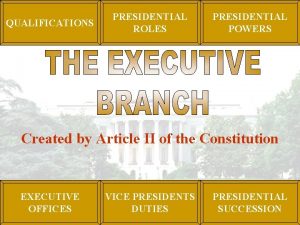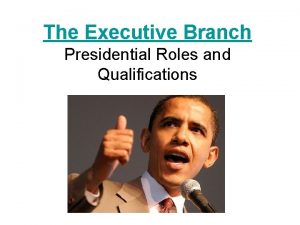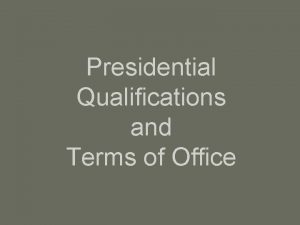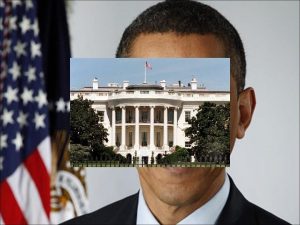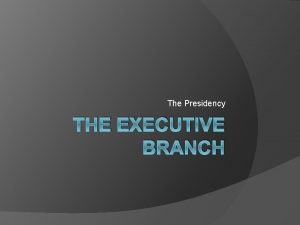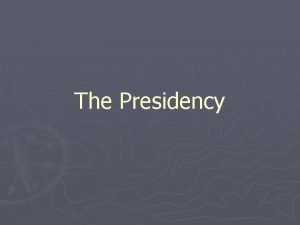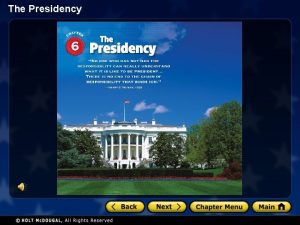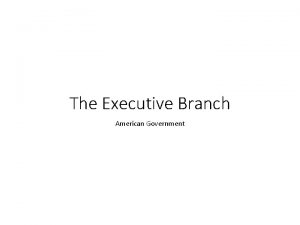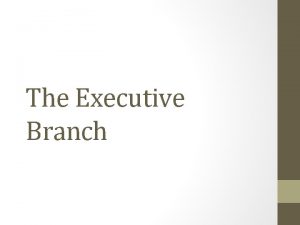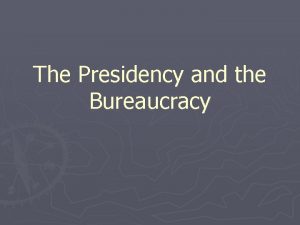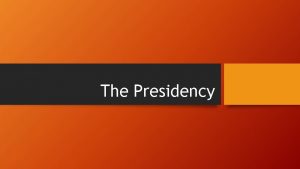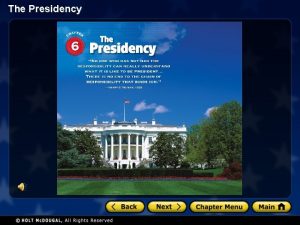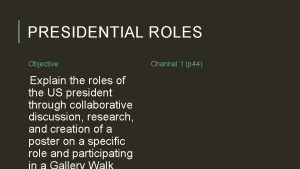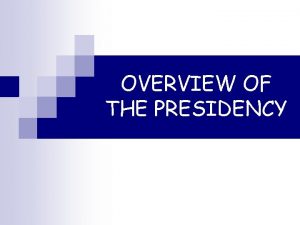THE PRESIDENCY OVERVIEW Qualifications Demographics Presidential Roles Organization


































- Slides: 34

THE PRESIDENCY

OVERVIEW Qualifications & Demographics Presidential Roles Organization of the Executive Branch Presidential Power

QUALIFICATIONS Article II, Section 1: Natural Born Citizen 35 years old 14 year resident of U. S.

PRESIDENTIAL ROLES Chief Executive oversee federal bureaucracy administer and execute the law

PRESIDENTIAL ROLES Chief of State: largely ceremonial or symbolic functions where President represents the country as a whole

PRESIDENTIAL ROLES Commander in Chief Civilian control of Armed forces.

PRESIDENTIAL ROLES Chief Diplomat negotiate and sign treaties appoint diplomats receive foreign officials negotiate and sign executive agreements

PRESIDENTIAL ROLES Chief Legislator recommend legislation to Congress set legislative agenda veto power

PRESIDENTIAL ROLES Chief of Party

CHECKS ON THE PRESIDENT Commander in Chief Congress declares war Congress controls budget War Powers Act (1973) 48 hour alert to Congress troops stay for 60 days pending Congressional approval With no approval, troops must be withdrawn

CHECKS ON THE PRESIDENT Chief Executive Senate must approve presidential appointments Civil Service protection for most appointees Congress controls the budget

CHECKS ON THE PRESIDENT Chief Diplomat Senate confirmation of ambassadors Senate confirmation of treaties Chief Legislator President does not have seat in Congress can override veto

CHECKS ON THE PRESIDENT Party Chief term limit and “lame duck” status loose organization of American parties makes it difficult to “lead”

THE PRESIDENTIAL ESTABLISHMENT Today, the president has numerous advisors to help make policy and fulfill the duties of chief executive. The Cabinet The Executive Office of the President (EOP) White House Staff

THE CABINET The Cabinet is not mentioned in the Constitution and is formulated by each president as he/she sees fit. The Cabinet consists of the heads of the major bureaucratic departments (State, Defense, Treasury, etc. ). Congress exercises some control over the bureaucracy -- through advice and consent and budget controls.

THE EXECUTIVE OFFICE OF THE PRESIDENT (EOP) The EOP was established by FDR and is a very important inner circle of advisors to the president. The EOP is staffed by persons responsible to the president alone The EOP includes such important offices as the National Security Council, the Council of Economic Advisors, and the Office of Management and Budget.

WHITE HOUSE STAFF The people most directly responsible to the president are the White House staff such as personal assistants, senior aides, administrative personnel and more. There is no Senate confirmation and their power comes solely from their personal relationship with the president. The White House staff reached a height of 583 members in 1972, but has gotten smaller since then generally running at around 400.

15 Departments

e. g. , WHO, CEA, NSC, OMB

e. g. , CIA, EPA, NASA, NRC, Peace Corps

PRESIDENTIAL POWERS Two types of presidential powers: Formal those determined by the statute and the Constitution Informal those based on tradition, personal traits, political and sociological realities

POWERS OF THE PRESIDENT Formal Powers Appointment Treaties and Foreign Policy Veto/Sign Legislation

POWERS OF THE PRESIDENT Special Executive Powers Executive Orders A rule or regulation issued by the president that has the effect of law. They can enforce legislative statutes enforce the Constitution or treaties establish or modify rules and practices of executive administrative agencies Published in The Federal Register EO by disposition (FDR to Obama)

PRESIDENTIAL POWERS Formal Powers include: Executive Privilege ability to withhold information from Congress or to refuse to recognize Congressional subpoena

PRESIDENTIAL POWER Informal Powers: Access to Media use of mass media allows president to reach public in a way that no other institution or politician in government can

PRESIDENTIAL POWER Informal Powers (cont’d) Persuasion Bargain with members of Congress and bureaucracy Success depends on variety of factors, including: personal communication skills partisan divide in Congress public approval ratings

POWERS OF THE PRESIDENT Executive Privilege The right of executive officials to withhold information from or to refuse to appear before a legislative committee Emergency Powers An inherent power exercised by the president during a period of national crisis

POWERS OF THE PRESIDENT Informal Powers Persuasion Personal communication skills Partisan divide in Congress Place in term Public Opinion ratings

POWERS OF THE PRESIDENT Source: Wall Street Journal


VICE PRESIDENCY Same requirements as president, except cannot be from same state as the president (12 th Amendment) President of the Senate Other responsibilities as designated by the President

REMOVAL AND SUCCESSION Removal: Election Impeachment Resignation Death Illness

REMOVAL Illness: 25 th Amendment President informs Congress If President unable to inform Congress, then VP does it, with majority vote of cabinet If dispute over whether President is able to return to office, 2/3 rds vote of Congress decides whether VP stays or not

SUCCESSION Succession Act of 1947 Pres VP Speaker of the House President pro tempore of Senate Cabinet Secretaries chronologically arranged by creation of department
 Guided reading activity choosing the president lesson 1
Guided reading activity choosing the president lesson 1 Presidential roles
Presidential roles Presidential roles
Presidential roles Project leadership matrix
Project leadership matrix Section 4 the presidency of john adams
Section 4 the presidency of john adams Washingtons presidency
Washingtons presidency Strict constructionist
Strict constructionist Chapter 12 section 2 the harding presidency
Chapter 12 section 2 the harding presidency Chapter 20 politics of the roaring twenties
Chapter 20 politics of the roaring twenties Chapter 6 the presidency
Chapter 6 the presidency President informal powers
President informal powers Apush chapter 7 hammering out a federal republic
Apush chapter 7 hammering out a federal republic Chapter 14 the presidency in action answer key
Chapter 14 the presidency in action answer key Chapter 14 the presidency in action
Chapter 14 the presidency in action Ch 12 section 2 the harding presidency
Ch 12 section 2 the harding presidency Presidential line of succession
Presidential line of succession What were president jeffersons economic policies
What were president jeffersons economic policies Summary of alien and sedition acts
Summary of alien and sedition acts American democracy now chapter 13
American democracy now chapter 13 Washingtons cabinet
Washingtons cabinet Institutional presidency definition
Institutional presidency definition Shwan rashid
Shwan rashid Uta maverick activity center
Uta maverick activity center Wine market council
Wine market council Matri shakti bima yojana
Matri shakti bima yojana Luxury consumer demographics
Luxury consumer demographics Walmart shopper demographics
Walmart shopper demographics Fiu demographics
Fiu demographics London demographics
London demographics Traffic director triage
Traffic director triage Lambert high school demographics
Lambert high school demographics Causes of homelessness orange county
Causes of homelessness orange county Ispic
Ispic Candy crush demographics
Candy crush demographics Nfl marketing strategy
Nfl marketing strategy
